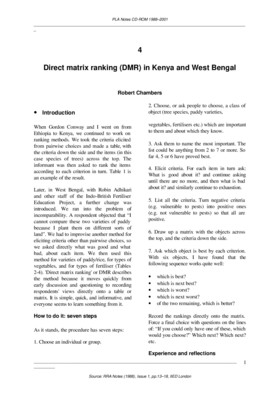Direct matrix ranking (DMR) in Kenya and West Bengal

When Gordon Conway and I went on from Ethiopia to Kenya, we continued to work on ranking methods. We took the criteria elicited from pairwise choices and made a table, with the criteria down the side and the items (in this case species of trees) across the top. The informant was then asked to rank the items according to each criterion in turn. ~ ~Later, in West Bengal, with Robin Adhikari and other staff of the Indo-British Fertiliser Education Project, a further change was introduced. We ran into the problem of incomparability. A respondent objected that “I ~cannot compare these two varieties of paddy because I plant them on different sorts of land”. We had to improvise another method for eliciting criteria other than pairwise choices, so we asked directly what was good and what bad, about each item. We then used thismethod for varieties of paddy/rice, for types of ~vegetables, and for types of fertiliser.
'Direct matrix ranking' or DMR describes the method because it moves quickly from early discussion and questioning to recording respondents' views directly onto a table or matrix. It is simple, quick, and informative, and everyone seems to learn something from it.
Cite this publication
Available at https://www.iied.org/g01317